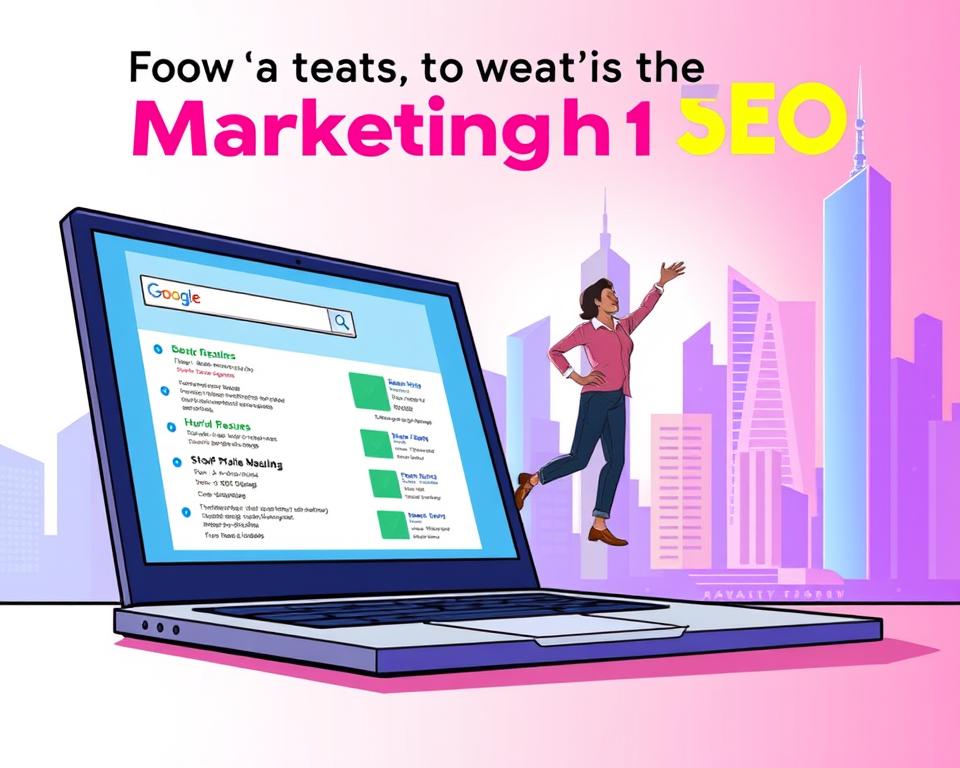Get to Know Web Marketing: Approaches to Scale Your Company
Are you aware 79% of customers conduct online research before making a purchase? This data point shows the indispensable role of a resilient online presence for enterprise development. In today’s digital era, becoming adept at Digital Marketing 1on1 SEO is vital for entrepreneurs and enterprise managers. It’s essential for engaging customers and increasing profits.
This article will explore effective internet marketing strategies to boost your business. Leveraging multiple online marketing avenues, you can more effectively reach your ideal customers. It cultivates long-term client loyalty.
While diving into online marketing, you’ll gain insights to succeed in the web environment. These insights are designed to help you navigate and thrive in this ever-changing environment.
The Role of Web Marketing in Scaling Your Business
Online marketing’s impact on today’s business expansion is immense. In today’s digital age, a solid web footprint is vital. It allows companies to find new customers and build rapport.
Through web marketing, companies can bring in new leads and build significant inquiries. This leads to a significant increase in sales. Specialists note that a cohesive internet plan raises exposure and forges brand–customer ties. Interactive material fuels these connections, driving customer loyalty.
Allocating budget to web marketing yields significant returns. Studies show that companies focusing on their online presence see more traffic, better user engagement, and higher sales conversions. Amidst competition, embracing a steady, powerful online marketing plan is crucial for expansion.

Key Strategies for Effective Online Advertising
Strong online ad tactics underpin successful digital marketing. Companies should employ diverse methods to connect with their audience. PPC ads serve as a foundation, granting instant visibility and broad reach. Google Ads, for instance, allows companies to target specific demographics based on user search behavior, boosting campaign efficiency.
Display ads are another critical component, grabbing user attention and fostering brand engagement. Social media ads create vibrant brand–customer dialogues.
Segmenting your market is crucial. Companies must analyze their target market to uncover interests, preferences, and behaviors. These insights shape persuasive CTAs that drive clicks. Ongoing review of ad stats is essential. It enables systematic campaign tweaks for continuous improvement.
| Strategy Type | Overview | Advantages |
|---|---|---|
| PPC Advertising | Paid ads billed by click. | Immediate visibility and targeted reach. |
| Visual Ads | Graphic ads showcased online. | Boosts recognition and interaction. |
| Social Media Promotions | Ads featured on social media platforms. | Direct interaction with a broad audience. |
By integrating these strategies, businesses can greatly enhance their online advertising efforts. Focusing on audience insights and making campaign adjustments ensures sustained growth in the competitive online space.
Search Engine Optimization (SEO) Fundamentals
Search engine optimization, or SEO, is vital for boosting a website’s visibility and driving organic traffic. Firms begin by researching high-value search terms. This step involves finding the terms and phrases that people often search for online.
On-site SEO plays a major role. Using meta tags, header tags, and high-quality backlinks correctly can significantly impact search engine rankings. They bolster your digital footprint for both Google and visitors.
Data indicate ongoing SEO yields significant traffic gains. Companies that invest in refining their SEO strategies see significant growth and visibility in their markets.
Expert SEO courses and software grant essential expertise. Embracing core SEO principles drives traffic and solidifies your online footprint.
Content Marketing Methods
Content-driven approaches underpin digital success. It means producing engaging material that attracts and stimulates responses. It enhances brand authority and brings in prospects via clever online tactics.
Using different content types can expand your reach. Consider formats like:
- Posts covering trends and professional insights.
- Videos that entertain and educate with visuals.
- Infographics that simplify complex data into visuals.
- Podcasts that engage through stories and discussions.
Producing interactive content retains users and boosts search rankings. It channels visitors back repeatedly, enhancing exposure. Varying your media helps engage all audience segments.
Infusing narrative into educational content amplifies results. Prioritizing useful content cements your status as an industry expert. Consequently, your business experiences consistent advancement.
Harnessing Social Platforms
Social media tactics are vital for visibility and customer interactions. Platforms like Facebook, Instagram, LinkedIn, and Twitter offer unique ways to engage and promote brands. It’s essential to find where your target audience spends most of their time online.
Tailoring posts to each network boosts engagement. Frequent posting, campaigns, and ad targeting deepen community ties. An active presence encourages users to interact more, turning followers into loyal customers.
Analytics tools for social media help businesses track engagement and understand audience behavior. Applying analytics optimizes your social strategy. It guarantees that successful content guides upcoming efforts.
| Channel | Audience Size | Best for Engagement | Formats |
|---|---|---|---|
| Meta’s Facebook | 2.8 billion | All content types | Images, videos, articles |
| IG | 1.4 billion | Stories and reels | Images, videos, ephemeral posts |
| 774 million | B2B engagement | Blog posts, updates | |
| X | 0.450B | Real-time engagement | Tweets, graphics, clips |
By leveraging social media marketing, businesses can effectively position themselves in the digital market. This fosters stronger connections with their audience and promotes brand loyalty.
Email Campaigns
Email outreach provides budget-friendly direct communication. With customized Internet marketing messages, brands can drive engagement and retention. It forges solid customer connections.
Segmented lists and automated newsletters are key to success. They let you send relevant content and regular updates. Compelling subject lines also play a significant role in driving higher open rates. Studies show that segmented email campaigns yield much better returns than generic ones.
Upholding subscriber privacy is paramount. Following spam regulations safeguards your brand and earns subscriber confidence. Delivering valuable content regularly keeps the audience engaged and interested.
All told, email campaigns are indispensable for digital marketing. When done thoughtfully, it bridges the gap between brands and consumers. It cultivates enduring ties beneficial to both sides.
Understanding Search Engine Marketing (SEM)
Paid search marketing elevates your site’s exposure. It allows businesses to swiftly reach their target audiences by placing ads in search engine results. This method secures immediate visibility, driving website traffic and boosting engagement.
SEM effectiveness stems from precise bidding and placement. Brands improve SEM by selecting targeted, high-intent keywords. It raises CTRs and elevates conversion potential. Implementing best-practice SEM delivers major visit increases.
SEM campaigns thrive on performance monitoring and analysis. By analyzing performance metrics, businesses understand customer behavior and preferences. This data aids in making informed decisions, ensuring advertising budgets are used wisely. Segmented SEM campaigns achieve stronger outcomes.
Web Analytics
Site analytics are critical for web performance. Analytics software tracks user journeys comprehensively. They monitor traffic patterns and user behavior closely. This performance tracking is essential for making data-driven decisions.
By analyzing web analytics data, businesses gain a deeper understanding of what drives user engagement. Data-driven insights refine strategy and budget. As insights emerge, firms can focus on areas with the most growth opportunities, leading to better marketing efficiency.
Turning data into action matters. It lets firms iterate and optimize campaigns. Ongoing analytics review informs both current and future plans. Data-led decisions yield substantial business advantages.
E-commerce Strategies
Creating a robust e-commerce presence is vital for today’s businesses looking to sell online. Begin with a site that balances design and usability. Customers prefer stores that are easy to use and work well on mobile devices.
Enhancing your product pages improves SEO and traffic. Combining ads and social promotions broadens your audience and sales. Providing reliable payment methods fosters trust and convenience.
Building customer loyalty is key to e-commerce success. Implementing rewards, discounts, and fast support boosts retention. Firms refining their digital presence enjoy larger sales and happier customers.
Do-It-Yourself vs. Done-For-Me Marketing
Online marketing presents multiple routes to success. Selecting DIY or professional services impacts results. A DIY approach lets business owners manage their digital marketing, using their personal insights and creativity. It may produce bespoke, inventive strategies.
Selecting agency support leverages advanced know-how. Specialists offer deep expertise and proven methods. They guarantee launch and ongoing campaign optimization. Professional services streamline processes and systematically hit targets.
When deciding between these digital marketing approaches, evaluating internal resources and commitment is essential. Both paths offer benefits; match them to your objectives for competitive advantage.
The Bottom Line
Embracing robust online marketing tactics drives company expansion in our internet era. SEO, content marketing, social media, and data analytics are essential. They form the basis of successful digital marketing campaigns. Leveraging these methods smartly elevates visibility and audience engagement.
The debate between DIY and DIFM marketing shows the importance of matching marketing goals with capabilities. It steers companies to align methods with means. As this article has shown, a commitment to digital marketing best practices and ongoing learning can greatly benefit a company’s online success.


